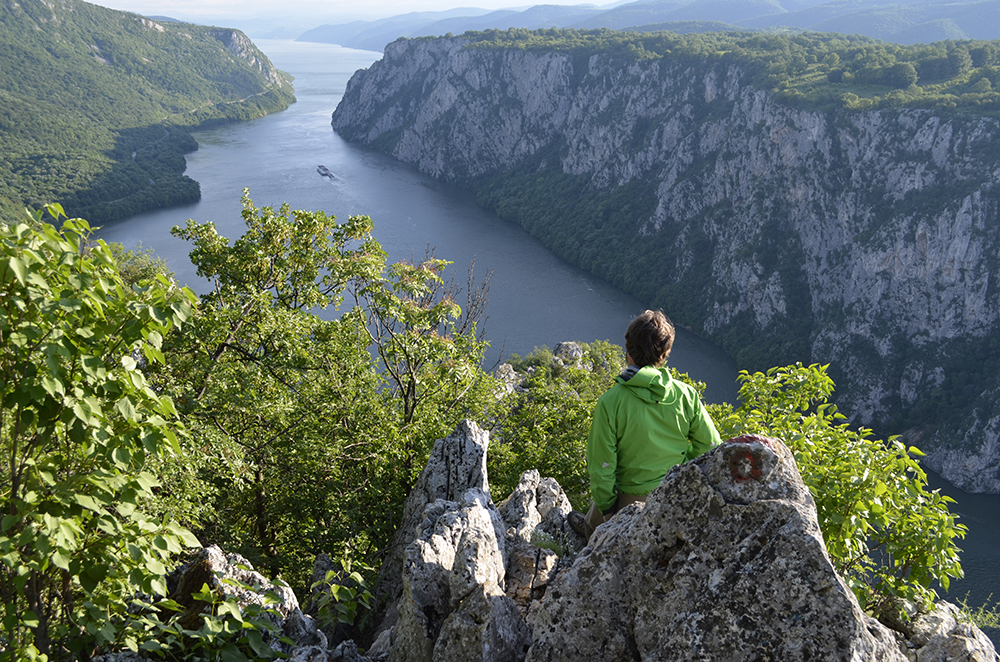Celebrating Earth Heritage
 Djerdap Geopark is situated in the SE Europe, in the north-eastern Serbia, at approximately 22° E and 44°50 N. The Danube River is natural and administrative border with the Republic of Romania as well as the main water corridor (the Pan- European waterway Corridor VII) linking the Black Sea and the Upper Danube catchment. In this area, the Danube has incised the longest gorge in Europe, which extends over a length of 100 km, and connects the Pannonian Basin in the West and the Dacian Basin in the East. Distance from the Serbian capital Belgrade is 200 km. The Geopark covers an area of 1330 square kilometres that belongs orographically to the Southern Carpathians. The climate is relatively mild; the annual average air temperatures are between 10 and 11°C, and the annual average precipitation sum is 784 mm. The elevation rises from 40 m a.s.l. (the Danube level) up to 810 m a.s.l. (Šomrda Mt.). This is predominately mountainous landscape with deeply incised valleys. River gorges, caves and natural bridges are the distinctive relief forms, shaped by active fluvial, slope and karst processes. The area is well known for its valuable cultural and natural heritage, geological in particular. It comprises four municipalities (Golubac, Majdanpek, Kladovo and Negotin) that belong to the administrative districts of Bor and Braničevo. About 41.000 residents inhabit this area. Family income is derived mainly from agriculture, animal husbandry and tourism.
Djerdap Geopark is situated in the SE Europe, in the north-eastern Serbia, at approximately 22° E and 44°50 N. The Danube River is natural and administrative border with the Republic of Romania as well as the main water corridor (the Pan- European waterway Corridor VII) linking the Black Sea and the Upper Danube catchment. In this area, the Danube has incised the longest gorge in Europe, which extends over a length of 100 km, and connects the Pannonian Basin in the West and the Dacian Basin in the East. Distance from the Serbian capital Belgrade is 200 km. The Geopark covers an area of 1330 square kilometres that belongs orographically to the Southern Carpathians. The climate is relatively mild; the annual average air temperatures are between 10 and 11°C, and the annual average precipitation sum is 784 mm. The elevation rises from 40 m a.s.l. (the Danube level) up to 810 m a.s.l. (Šomrda Mt.). This is predominately mountainous landscape with deeply incised valleys. River gorges, caves and natural bridges are the distinctive relief forms, shaped by active fluvial, slope and karst processes. The area is well known for its valuable cultural and natural heritage, geological in particular. It comprises four municipalities (Golubac, Majdanpek, Kladovo and Negotin) that belong to the administrative districts of Bor and Braničevo. About 41.000 residents inhabit this area. Family income is derived mainly from agriculture, animal husbandry and tourism.
© Public enterprise Djerdap National Park
Sustaining local Communities
Djerdap Geopark features some of the most diverse and gorgeous geology, spanning from the oldest Proterozoic rocks to the youngest Quaternary sediments. The powerful Danube incised into the mountains, leaving behind fascinating geological profiles, such as those in Pesača (stratotype of Jurassic and Cretaceous in the Southern Carpathians) and in Boljetinsko Brdo (classic Lower Cretaceous facies with cephalopods). At the beginning of Paleozoic, а peridotite-gabbro-leucogranites intruded a cratonized basement of metamorphics (600–550 Ма). Intensive igneous activity was in contrast with limited sedimentation. I-type granites reflected to the existence of a subduction zone at the end of Carboniferous. Permian age characterizes thick deposits of red land- formed sandstones and conglomerates, which locally disrupt spilite, porphyrite and pyroclastic rocks. Land remained until the Liassic transgression, when noteworthy Template/example 2016 marine sedimentation of shallow-water clastites and limestone with hard-ground and Ammonitico rosso took part. The end of Jurassic / beginning of Cretaceous marked the deposition of deep-water limestones with radiolarian-rich cherts, including ammonite-rich marlstone and marly limestone. The end of Albian stage is also the end of sedimentation in Danubicum. Laramian plutons emplaced at the Cretaceous/Paleogene boundary. The epicontinental seas (Western and Eastern Paratethys), which existed in Neogene, included several basins. The Djerdap (Intra-Carpathian) strait was one of the straits responsible for their communication. Miocene sediments are clastites, marlstone and coals, while the youngest Quaternary sediments are alluvial, occasionally gold-bearing sediments, amongst others.
Related information
- Global Geopark Network Designated Year: 2020
- Localisation: 22° E and 44°50 N.
- Area: 1330km2
Official representative
- Lazar Mitrović Director, Djerdap National Park; office@npdjerdap.org
